Název: Las formaciones parasintéticas en el español moderno (1726–1904) : la morfología paradigmática y la motivación léxica desde la perspectiva diacrónica
Variantní název:
- The parasynthetic formations in modern Spanish (1726–1904) : the paradigmatic morphology and lexical motivation from the diachronic perspective
Vydání
Primera edición
Místo vydání
Brno
Nakladatel
Filozofická fakulta, Masarykova univerzita
Rok vydání
2017
Rozsah
478 stran
Edice
- Opera Facultatis philosophicae Universitatis Masarykianae = Spisy Filozofické fakulty Masarykovy univerzity, ISSN 1211-3034; 474
ISBN
978-80-210-8796-5
978-80-210-8797-2 (online : pdf)
Trvalý odkaz (DOI): https://doi.org/10.5817/CZ.MUNI.M210-8797-2017
Trvalý odkaz (handle): https://hdl.handle.net/11222.digilib/137570
Jazyk
španělsky
Odkaz do knihovního katalogu MU: 6408821
Více
Anotace
- Parasyntéza představuje zvláštní a lingvisty polemizovaný mechanismus tvoření slov, jak ze synchronního tak z diachronního hlediska. Proto kromě detekce a identifikace parasyntetických neologismů v tzv. moderní španělštině navrhuje autorka ve své monografii model, který v dané otázce skýtá koherentní přístup. Opírá se o nedávné teorie formulované z pohledu paradigmatické morfologie a teorie lexikální motivace. Na základě těchto dvou teorií vyvinula model paradigmatické organizace lexika. Tento model bere v úvahu vliv cizích jazyků spolu s mimojazykovými faktory a zároveň také představuje lexikum jako komplexní síť paradigmat a vztahů vzniklých uvnitř paradigmat a mezi těmito paradigmaty. Analýza autorky ukazuje, že neologismy mohou být výsledkem vzájemné spolupráce tří základních vztahů (motivací): intralingvistické, interlingvistické a nadstavbové motivace.
- Parasynthesis is a strange and controversial mechanism of word formation, both from synchronic and diachronic perspective. Therefore, in addition to the detection and identification of parasynthetic neologisms in so-called modern Spanish, the author proposes a model that offers a coherent approach to the issue. She relies on recent theories formulated from the perspective of paradigmatic morphology and the theory of lexical motivation. Based on these two theories, the author developed a paradigmatic model of lexicon. This model takes into account the influence of foreign languages along with non-linguistic factors. At the same time the model also represents the lexicon as a complex network of paradigms and relationships arising within and between these paradigms. The analysis shows that neologisms can result from mutual cooperation between three basic relationships (motivation): intralinguistic, interlingual and adherent motivation.
Předmětová hesla
Ústav FF MU
Obor
Licence: Neurčená licence
Držitel práv
Monika Šinková
Masarykova univerzita
Přístupová práva
přístupné po uplynutí embarga
Upozornění: Tyto citace jsou generovány automaticky. Nemusí být zcela správně podle citačních pravidel.
| Chapter number | Title | Custom text |
|---|---|---|
| Prólogo | 11–15 Šinková, Monika |
| Chapter number | Title | Custom text |
|---|---|---|
| 1 | | Tres modelos morfológicos en el contexto de la diacronía y de la parasíntesis | 17–26 Šinková, Monika |
| Chapter number | Title | Custom text |
|---|---|---|
| 2 | | La morfología paradigmática | 27–33 Šinková, Monika |
| Chapter number | Title | Custom text |
|---|---|---|
| 3 | | Analogía en la formación de palabras | 34–38 Šinková, Monika |
| Chapter number | Title | Custom text |
|---|---|---|
| 4 | | La motivación lingüística | 39–50 Šinková, Monika |
| Chapter number | Title | Custom text |
|---|---|---|
| 5 | | La parasíntesis en la morfología paradigmática | 51–77 Šinková, Monika |
| Chapter number | Title | Custom text |
|---|---|---|
| 6 | | La evolución de los esquemas parasintéticos | 78–83 Šinková, Monika |
| Chapter number | Title | Custom text |
|---|---|---|
| 7 | | Parasíntesis en las cuatro lenguas románicas analizadas | 84–86 Šinková, Monika |
| Chapter number | Title | Custom text |
|---|---|---|
| 8 | | Formaciones parasintéticas de los siglos XVIII y XIX | 87–446 Šinková, Monika |
| Chapter number | Title | Custom text |
|---|---|---|
| Conclusiones generales | 447–453 Šinková, Monika |
| Chapter number | Title | Custom text |
|---|---|---|
| The parasynthetic formations in modern Spanish (1726–1904) : the paradigmatic morphology and lexical motivation from the diachronic perspective : summary | 454–458 Šinková, Monika |
| Chapter number | Title | Custom text |
|---|---|---|
| Bibliografía | 459–478 Šinková, Monika |

